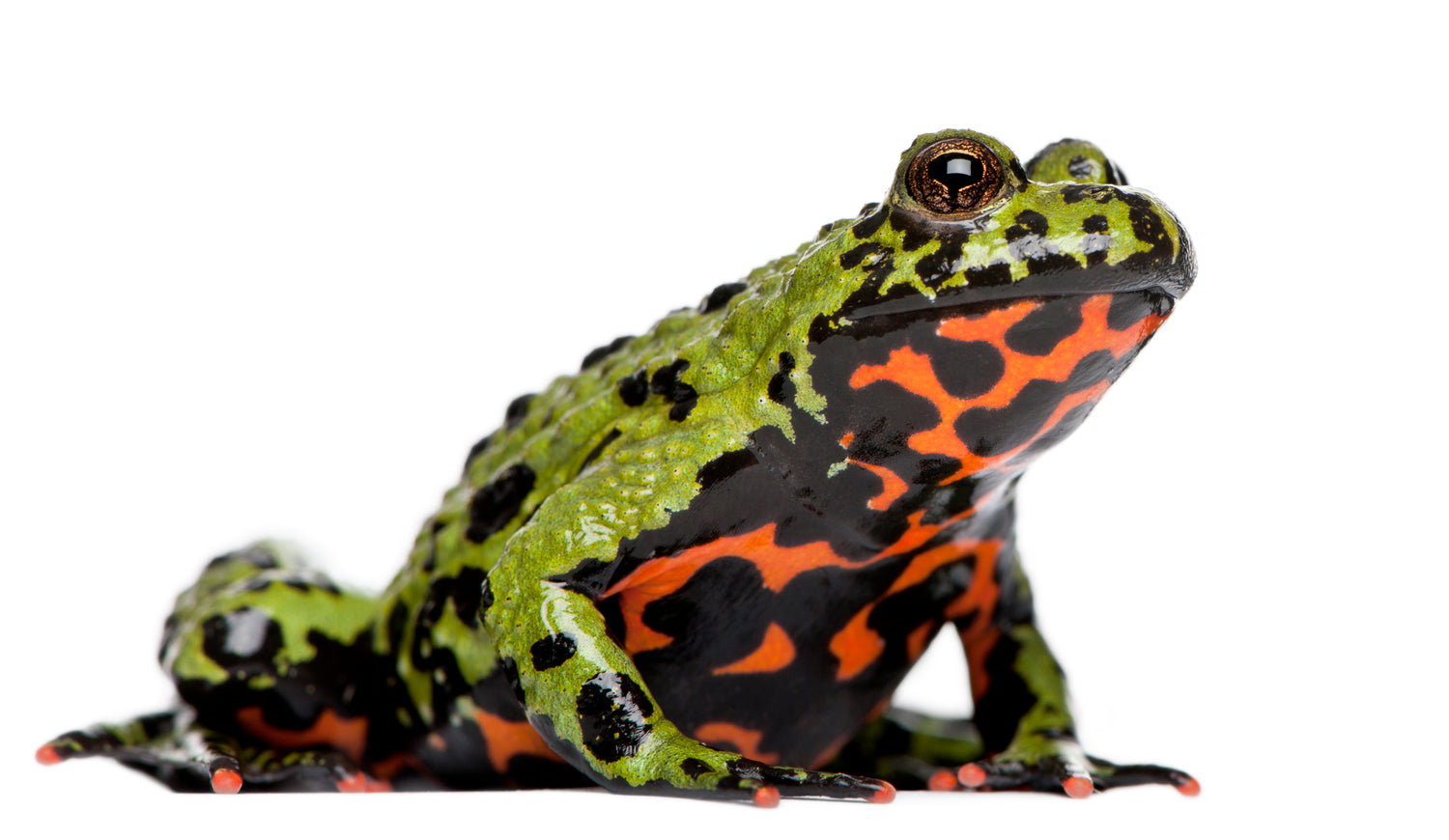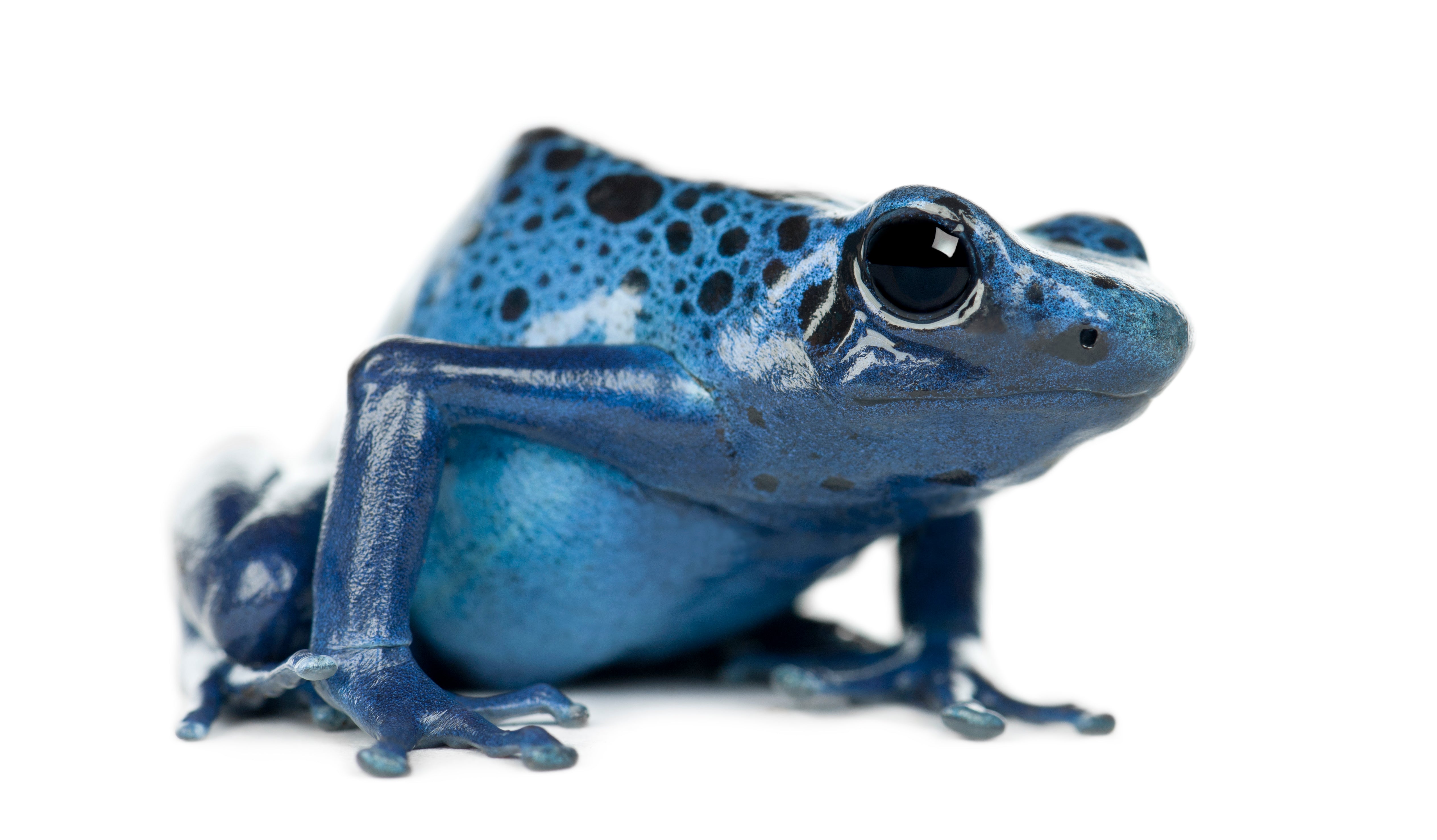The fire-bellied toad (Bombina orientalis) is a small, semi-aquatic, diurnal species of amphibian. They are native to Korea, northeastern China, Thailand, and southern Japan. They can also be found in certain regions of Russia, and are invasive in Beijing. Fire-bellied toads are hardy and can live in a variety of habitats, including forests, river valleys, swamps, and meadows. They usually prefer to stay fairly close to water.
Fire-bellied toads are typically 1-3” long from snout to vent, with large heads, squat bodies, short legs, and bumpy skin. They are green on top and orange-red on bottom, with brown-black markings on both sides.
Due to their small size and general hardiness, fire-bellied toads are beginner-level pet amphibians. With good care, they can live up to 20 years, and quite possibly more!
How much space do fire-bellied toads need?
To house a group of 2-3 fire-bellied toads, you will need an enclosure no smaller than 24”L x 12”W x 12”H, or 15 gallons. This is just the minimum, so using larger dimensions is beneficial and will happily be used!
Cohabitation (keeping multiple fire-bellied toads in one enclosure) is recommended, as species seems to do well in groups. For housing more than three toads, you will need to add at least 5 gallons of space per additional toad.
Do fire-bellied toads need UVB?
They seem to be able to survive without it, but it’s still best practice to provide UVB lighting for optimal health and wellbeing. Fire-bellied toads are active during the day, which means that it’s very likely they’re naturally exposed to sunlight on a regular basis. Providing UVB lighting to your toads gives them all of the vitamin D that their body needs, stimulates better appetite and activity, and generally allows them to be healthier than they would be without.
The best UVB bulbs for fire-bellied toads housed are:
- Zoo Med T8 Reptisun 5.0
- Arcadia ShadeDweller
The UVB bulb should be housed in a reflective fixture like the Arcadia ProT5 or Vivarium Electronics, and placed close to the heat lamp on top of the mesh lid, about 8-13” above the substrate. UVB is blocked by glass and plastic, so you can’t give your frog UVB by placing its terrarium in front of an open window. Also make sure that the fixture your UVB bulb is in does not have a clear plastic bulb cover. UVB bulbs decay over time, so don’t forget to replace your bulb every 12 months to maintain good performance.
Lights should be on for 12 hours/day during summer and 8-9 hours/day during winter.
What temperatures do fire-bellied toads need?
Fire-bellied toads are ectotherms, which means that they rely on the temperature of their environment to help regulate their metabolism and stay healthy.
Daytime temperatures should be around 78°F during summer, and may drop down to around 70°F during winter. Measure air temperatures in these locations with digital probe thermometers, with the probe placed in the desired area. Temperatures should never get above 82°F or below 60°F.
A good way to warm the enclosure is with a low-wattage heat lamp on one side of the enclosure. Do not use colored bulbs, as these are not as effective. Increase the wattage if it’s too cool, and use a plug-in lamp dimmer if it’s too warm.
Heating should be turned off at night.
What humidity levels do fire-bellied toads need?
As amphibians, fire-bellied toads are very dependent on water — especially when they’re still just tadpoles! Average air humidity should stay around 50-80%, as measured by a digital probe hygrometer. If needed, misting your frog’s enclosure daily with a sprayer will help create the right humidity levels.
Fire-bellied toads are semi-aquatic, which means that roughly half of the enclosure should be filled with 1-2” of water. This means that you will either need to place a large, removable tub of water inside the enclosure, or you will need to create a paludarium setup that functions like a shallow aquarium plus dry land.
If you go the water tub route, waste and debris will need to be removed daily, and the tub itself will need to be removed and scrubbed with amphibian-safe disinfectant once a week. The new water must be spring water or treated with dechlorinator before replacing — never used distilled or reverse-osmosis water for your frog!
If you turn the enclosure into a paludarium, you will need an appropriately-sized filter to keep the water clean, which requires specific routine maintenance of its own. Adding certain live aquatic plants can help maintain good water quality on top of the filter.
What substrate is good for fire-bellied toads?
Fire-bellied toads require a thick layer of moisture-retentive substrate to cushion their bodies and help maintain healthy humidity levels. As an added perk, it also tends to make the enclosure more attractive.
For the land portion of the enclosure, this substrate should have small particles and hold moisture well. It should also be able to support plant life if you are using live plants:
For the aquatic portion of the enclosure, substrate is not required.
Remove poop and urates daily. If you are not using a bioactive paludarium setup, substrate should be replaced every 2 months to maintain good hygiene.
What décor can you use in a fire-bellied toad terrarium?
It’s terribly boring for a toad to be stuck in an enclosure with nothing in it except land and water. It doesn’t matter how big the enclosure is if you don’t put things in it for your pet to use and interact with.
Décor options for fire-bellied toads include:
- leaf litter
- mopani wood
- cork bark
- rocks
- live or artificial plants
- pre-made hides/caves
- artificial ornaments
Whatever you choose to use, make sure that the toads have cover to hide in so they can feel secure in their environment.
What do fire-bellied toads eat?
Fire-bellied toads are insectivores, which means that they need to eat live insect prey in order to get the nutrition that they need. Each toad should be fed 2-6 appropriately-sized insects 1-2x/week. One appropriately-sized insect will be slightly smaller than the width of the toad’s head.
Despite the fact that they are insectivorous as adults, fire-bellied toads tadpoles are actually mostly herbivorous, eating algae, fungi, plants, protozoans, and detritus.
Food options for fire-bellied toads:
- Black soldier fly larvae
- Black worms
- Crickets
- Dubia roach nymphs
- Earthworms
- Ghost shrimp
- Guppies
- Hornworms
- Mealworms
- Silkworms
- Snails (captive-bred only)
- Tubifex worms
Supplements
Fire-bellied toads need vitamin and mineral supplements to enjoy optimal health. We recommend Repashy Calcium Plus LoD, lightly dusted on their prey at each feeding. Occasionally skipping a dusting is fine.
Do fire-bellied toads like to be handled?
Very few amphibians actually “like” to be held, and fire-bellied toads are not one of them. In fact, they are mildly toxic as well as sensitive to potential toxins present on human hands, so it’s best to stay hands-off with this pet.
Handling should be kept to an absolute minimum, but when you have to grab your toads, wear a pair of nitrile gloves, use an aquarium net, and gently coax them into a plastic container. Always wash your hands after working your toads or their enclosure!
*This care sheet contains only very basic information. Although it’s a good introduction, please do further research with high-quality sources to obtain additional information on caring for this species.




Leave a comment
This site is protected by hCaptcha and the hCaptcha Privacy Policy and Terms of Service apply.